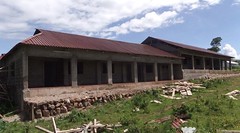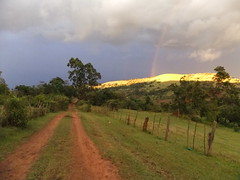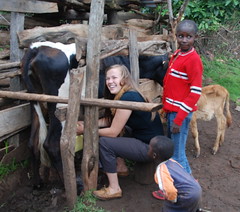I promised a summary of what we have been doing. It may verge on dull, but for the sake of expediency and to quell the inquiries, I am going to give you a full cheat sheet to some of the bigger things that we have accomplished over the past few weeks:
1. Field Trips! The school was scheduled to undertake its first ever field trips at the end of March, but when I arrived, no plan whatsoever had been discussed. The new headteacher, paid by the government and with less than appropriate regard for Kakenya’s plans for the school, had simply ignored the request to organize the trips. Still, we pulled it off, taking the standard 4 and standard 5 girls to Rusinga Island for a day, and the standard 6 girls on an overnight adventure to Lake Nakuru National Park and the surrounding area. These trips are especially important for broadening the horizons of students from rural and under privileged families. For example, some of these girls had never seen tarmac roads before…It was such a privilege to be there and document their amazement at all of the seemingly distant things they saw. Soon I will post a full retrospective blog on the field trips, or “tours” as they are called here in Kenya.
2. Construction: As a result of some less than trustworthy business partners, construction on the school’s first proper dormitory has taken months longer than it should have. HP recently donated a bunch of computers to Kakenya’s project, but we haven’t been able to have them arrive at the school yet for lack of space. We had to make a choice between a place for the girls to sleep and a place to house the computers. Some of the girls probably want computers so badly at this point that they would rather sleep outside if it meant they could get the desktops installed. Bringing the computers in so that I could help increase ICT capacity here really motivated me to make sure the construction of the dormitory building got back on track. Likewise, the classroom building had not had power for over a month, due to a sly electrician having used poor quality wiring the first time around. This isn’t a big deal in a town where few houses have electricity and the electricity to town can be down for days at a time, but it is a big deal to the students’ studying hours. When they have lights, the girls are happy to go straight to preps before light in the morning, and stay studying after dinner until bedtime. Without lights, these are just wasted hours. All the process really needed in order to get reenergized was a person on the ground who would be consistently overseeing progress and transactions. To be honest, as I forecasted my workplan with Kakenya, we hadn’t anticipated quite how much I would be working on this aspect of the project nor that it would take up such an exorbitant amount of my time. But seeing the lights back on in the classroom and seeing that the building is ready for the girls to move out of their temporary housing (two to a bed in one of the classrooms!) makes me feel like we have really achieved something tangible since I got here.
3. Community impact assessment: Something else that we have started, and that I will be returning to in May and June, is what I call the attempt at small scale monitoring and evaluation. It is what we can do in lieu of funding for a proper monitoring and evaluation scheme. For my part, I have begun to test a “prototype” of a community impact assessment survey, which is really more of a semi-structured interview with a convenience sample. Being here, one knows the impact and importance of the school and of Kakenya’s Dream, but we need something more concrete to point to, and personally I am a strong supporter of results based projects. Unfortunately, Kakenya never had any sort of baseline survey presumably because at the beginning of her project that wouldn’t have yet been warranted. Still, we are starting from now, starting small and getting some information which we hope will continue to raise monet through which we might be able to fund a more thorough one. Still since we’ve never has a baseline, every year we wait we get more and more behind on getting a “profile” of the community and its attitudes towards FGM, and we become less able to assess the long term changes in the community to which Kakenya’s Dream and its community projects and school are contributing. This is hugely important to the potential to scale up this school and vision beyond Enoosaen.
4. Camp: We are about to wrap up the April school holiday and this past week, we held a four day health and leadership workshop (aka summer camp). I have been working with several of Kakenya’s friends and some interesting and outspoken women teachers from around the village to set this in motion. Because we had to start planning only two weeks into my time here, orchestrating certain things (how to feed 80 people and how to bring together the necessary group of trainers on health and leadership topics) in a rural village in Kenya was a little daunting. Still, I think the general consensus is that the camp was a success, and it was certainly more successful than I had ever imagined it would be. Look out for the next post on this!
5. Organizational transition: Some of you reading will know that Kakenya’s school became registered as a government school in January. This is important to the long run vision of making this school an model for widely available high quality girl-focused education in Kenya, but it does not mean that the government is contributing much in the way of funds (thus far, one teacher, no books, and nothing else at all). So, in order to ensure that Kakenya’s vision is still fully carried out, she has decided to make an organizational transition in the way funding is handled once it reaches Enoosaen, a transition that reflects that of the school’s new designation as a government school. So, it was decided mere weeks before I arrived, that a board of long term, committed, and trustworthy locals would become the board of what is now the Kakenya’s Dream organization in Kenya, a sort of parallel to the NGO in the states. Kakenya will be posting information about these fantastic individuals on her website soon.
Since I’ve been here, we have announced the organizational shift and I have been working with the Kakenya’s Dream board and the local education offices to draft a memorandum of understanding and new contracts between the school staff and the organization. These contracts will mean that no matter how neglectful the government is (the deficiency of Kenyan education one of the reasons the school exists, after all), performance standards for teachers will remain high.
6. Starting on ICT with teachers: We are beginning to digitize exam scores. The school was already doing this intermittently, but getting a system in place for who inputs the exam scores and when, after every exam, is important to making sure we have up to date information about how each pupil is doing. This is the best indicator we can have of each girls’ progress and increased chances of getting into the best high schools. We should be able to track them and their individual progress more easily than we have been able to in the past, and this will become easier once we have the computers that HP donated delivered and running. This is happening with some big help from Kakenya’s team in the U.S., but my time here is up I want to get these teachers producing Excel graphs for every student and every grade, so they can see who is falling through the cracks in comparison to the others!
7. Profiles: Many of you saw the profiles of the students that Kate Cummings, a former AP fellow did. I am in the process of updating those that she did, and compiling profiles for all of the standard 4 and standard 5. We do this in free time around lunch and during games time after classes. Only about 40 students to go!
8. Managing the teaching staff and systems at the school: We are working to build a stronger and more motivated teaching force. In Kenya, it seems, there is an enormous focus on a student’s mark on the standardized government exams at the end of each term and year. This is most true for the leaving exams at the end of “primary school” in standard eight (comparable to eighth grade). Unfortunately, the system for exams has bred an educational system that, from what I can see, lacks critical thinking and isn’t conducive to a teacher paying close attention to individuals’ needs as learners. This speaks also to a commonly encountered culture of apathetic, dull teaching here. This makes for an especially uphill battle when dealing with some of the kinds of girls that the Enkakenya Centre for Excellence specifically recruits for its school: the girls who have had the least ch ance at a strong education in the past. Upon arrival in Standard four, several of our girls couldn’t read or write a word in English (the usual language of education here in Kenya), or couldn’t write full sentences in their mother tongue. To tease a sense of worth, academic potential, and confidence out of these girls requires a dedicated teaching staff above all. As this school has grown, however (each year the school adds one grade – we now have standard 4, 5, and 6), the staff has become less and less committed and cohesive, since there is less of a close tie to each individual girl. I saw it as a red flag that teachers are often uninformed of each others’ absences or school events, and that the teachers don’t have one time set aside to deal with staff-wide issues. At the crux of strengthening the Kakenya’s Dream organization, then, is strengthening the teaching staff, who manage the pupils, curricula, activities, and the happenings on the school grounds every day. A communicative staff makes systems at the school more sustainable and the school stronger as a whole.
We are working on this by bringing in teacher meetings that provide a previously unavailable forum for open dialogue about problems without focusing blame but instead focusing on solutions. Sometimes it is like pulling teeth, but I have faith it will be a worthy exercise in the long run. We have also implemented a notice board for teachers to make messages of absences and the like available to everyone, as well as monthly meetings of all teachers of each class of students, so that the teachers can discuss each individual pupil’s progress, creating “case notes” of a sort. To help with this, we have also opened a file for each of the 94 current students, which I am hoping will do wonder for consolidating information that previously has been particulate and residing only in the minds of several teachers at one time.
On a personal note (as if the mere existence of a blog isn’t?), one of the things I had considered most when taking on this position was that I truly felt it was a position that should be filled by a foreigner rather than a Kenyan because of the need at this juncture in the organization’s development to have a link between the sponsor’s perspective and the happenings on the ground. Still cognizant of the risk of being both redundant and ignorant as a consequence of my being an outsider, I came here with the mindset that it is imperative not to be extraneous, and to be more help than harm as a newcomer to the organization – and this I still believe. I have a strong faith in the knowledge of a local person, wherever one is and whatever the project. With that in mind I began my time here repeating the vague maxims to myself to simply not step on too many toes and always work with the larger vision of Kakenya’s dream in mind. I wanted to empower the permanent members of this project rather than interrupt the systems that may already work for them but aren’t systems to which I am accustomed. The funny thing is I’ve spent a month now learning, watching, and listening, and I no longer hold the naïve belief that not stepping on toes is always compatible with moving a project in the right direction.
9. Living it up: Last but not least, I am starting to learn some new skills. I am learning about where I can get the cheapest photocopies and the market days in the surrounding towns. I am learning to predict when rains will come in time to make the necessary arrangements. My Kiswahili might be coming on slowly, but I am learning loads of subtle and not so subtle cues like how I can never let adults see me serve them or they will start to disrespect me and how it is inappropriate to talk about pregnancies. Most importantly, last week I carried 12 kgs of millet on my head, I am making headway in milking cows (I can finally coax some milk out) and I just started my first “shanga” (maasai beading) project! Alas, everyone still has me drink from special cups and laughs hysterically if I sit on the floor in the kitchen with the children. Being a guest for 6 months can really make you feel like you’re putting people out. So, if working on fitting in (despite the fact that this is almost categorically impossible) makes me feel a little better, and gives the onlooker a chuckle, all the better.
Posted By Charlotte Bourdillon
Posted Apr 30th, 2011







2 Comments
Sarah Craven
April 30, 2011
Charlotte – You are amazing. Thanks for this incredibly rich posting. So glad the April camp and the field trips were a success. I saw Iain yesterday and we were both commenting on what an incredible life adventure you are having. Can’t wait to read your next update. Hugs, Sarah
Annette Scarpitta
May 1, 2011
Charlotte – Your progress there floors me. You are singlehandedly accomplishing what several people could not do. Changing the mindsets of people – especially the more obstinate ones – must surely be among your most challenging tasks. Continued good luck, and my best wishes to all the girls!